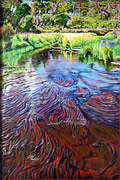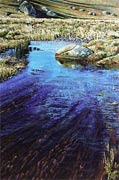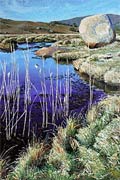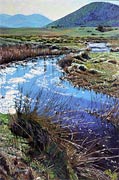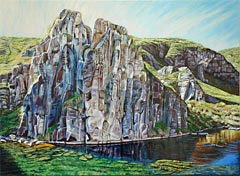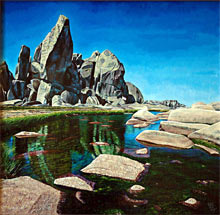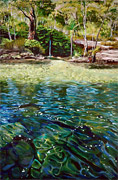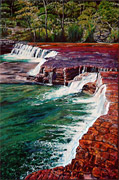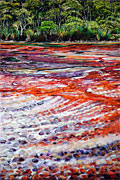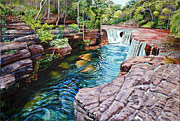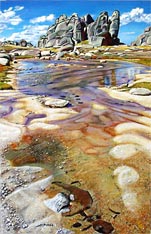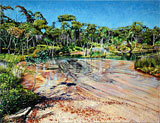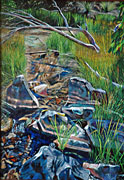Water series
Living in Canberra from 1993 to 2005 brought home to Phil the importance of water to all Australians.
Canberra is in a rain shadow and has traditionally low rainfall (600-700 mm/yr) but the period Phil lived there coincided with the worst drought in the last century for eastern Australia. Annual rainfall dropped below 400 mm and even the ACT dams in the Brindabella Mountains started to run low. Then at the height of the drought in January 2003 came catastrophic fires that burnt some 500 houses, the majority in suburbs close to where Phil lived in Western Creek.
Combination of fire, drought and water restrictions meant that most Canberra gardens and parks were brown, parched wastelands. So when it can time for Phil to move out of Canberra he wanted to find somewhere that was cool and wet. Kunama fitted those criteria.
Water in Myopic Landscapes paintings
The presence of water in landscapes has a particular significance for Phil. It is a wonderful precious natural resource and a delight when encountered in the brush. Water also presents numerous challenges to an artist.
Light and colour
Water is a substance that transmits, reflects and refracts light.
What colour is water?
In a single scene it can reflect the blueness of the sky and also transmit the colours of the stream bed. This produces a duality of surface and subsurface.
Water is unique and requires various skills, tricks and media to depict.
Use of glazing and gel media can achieve some of the effects seen in water. This method has been used in Paddys River, Trout Dreaming for Neil Trilogy, Karst Country: Blue Waterholes 3, and North Rams Head Tarn 4:
Movement and transformation
Water can also be the most dynamic feature of a landscape and it is a challenge to depict its movement and transformation in a convincing way. Waterfalls are a good example:
The Fruit Bat Falls Trilogy and Twin Falls - Eliot River show how at a waterfall the water undergoes three sequential phases; upstream laminar flow where it is near transparent, the falls where it is in a state of chaotic turbulence, and downstream where the turbulence has diminished and order is redeveloping.
High Country Waterfalls series focuses on waterfalls from southern NSW
.Texture
Texture is the final feature of water that is a challenge to capture in paint.
Smoothness and "wetness" of water is often in sharp contrast to adjacent rock or gravel, this is captured in North Rams Head Tarn 1 and OTL Creek Crossing:
As it also is with reeds, as seen in Karst Country; Cave Creek 2:
Mixed media such as sand or acrylic beads can emphasise this texture contrast between rock and/or gravel and water.
Find out more about Phil's art:


